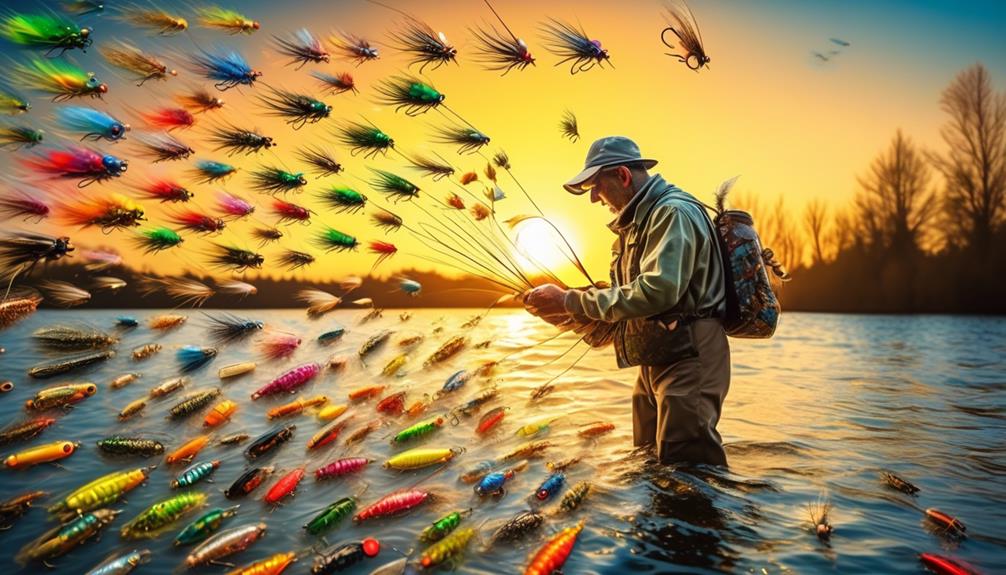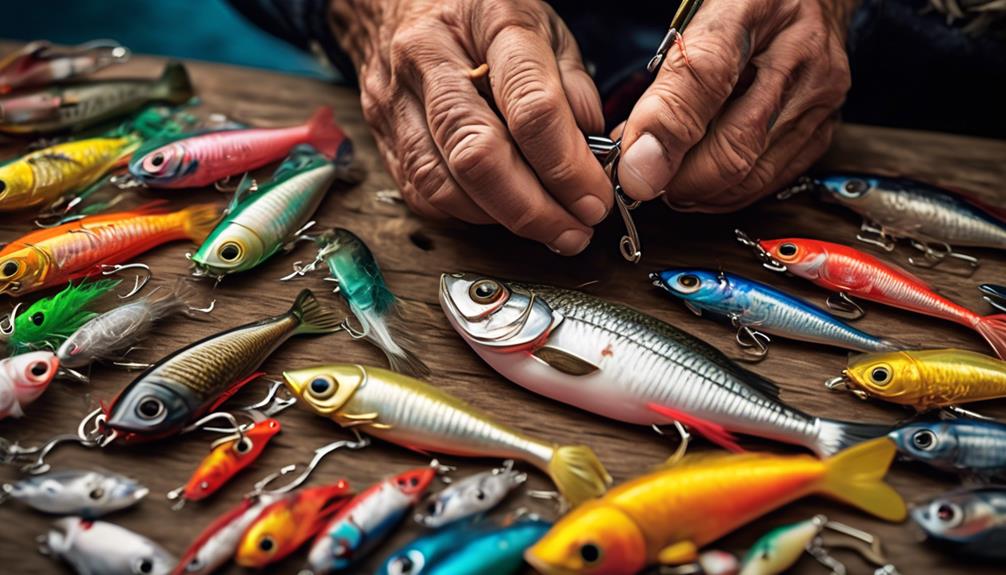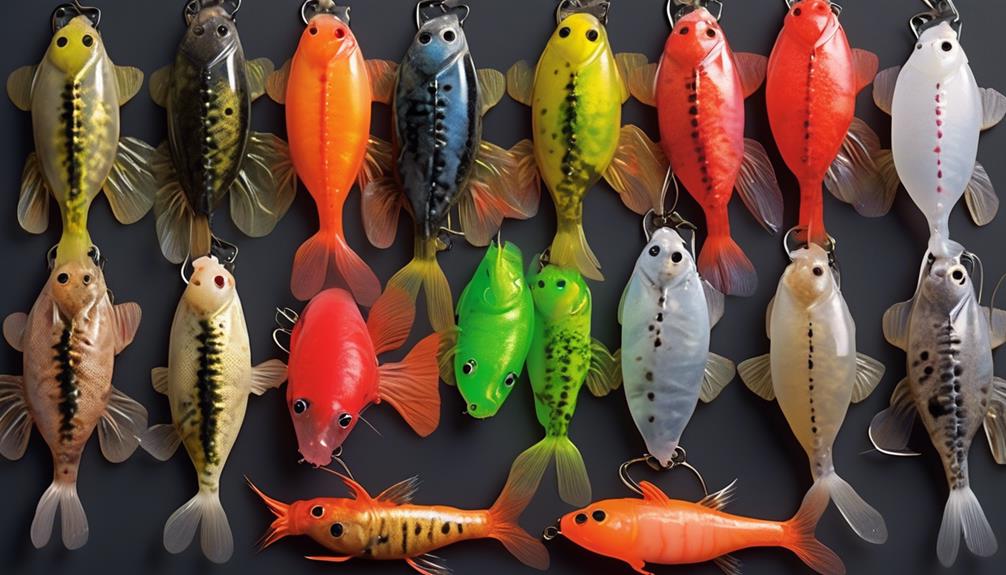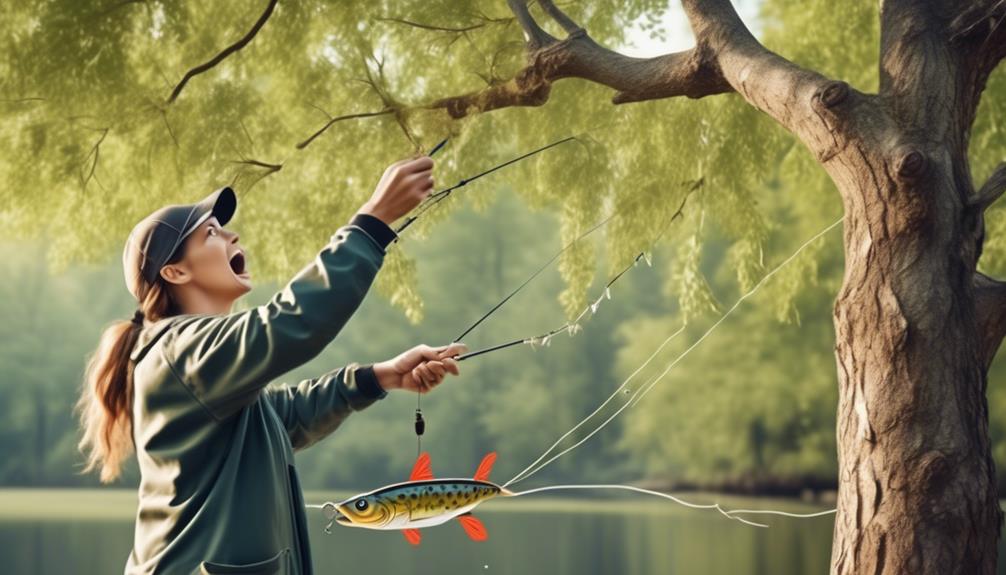When it comes to mastering fly fishing lure selection, understanding the behavior of the fish, matching lures to water conditions, and selecting the right fly size are just the beginning.
But, what about identifying the key insect hatches, exploring streamer versatility, evaluating nymph patterns, assessing dry fly options, and adapting to changing weather conditions?
It's a complex puzzle that requires attention to detail and a keen understanding of the environment.
Whether you're a novice angler or a seasoned fly fisher, there's always more to learn when it comes to honing your lure selection skills.
Understanding Fly Fish Behavior
To successfully catch fly fish, it's essential to understand their behavior and feeding patterns. Fish feeding habits can vary based on factors such as water temperature, time of day, and the presence of natural food sources. Observing the surface of the water to identify the type of insects that the fish are feeding on is crucial. Once you've determined their preferred food, you can tailor your fly presentation to mimic those insects, increasing your chances of a successful catch.
When it comes to fly presentation, it's important to consider the size, color, and movement of the flies. Matching the size and color of the natural insects can greatly enhance the effectiveness of your presentation. Additionally, understanding the behavior of the specific fish species you're targeting is essential. Some fish are more aggressive and may respond well to a fast-moving fly, while others may be more selective and require a more delicate presentation.
Matching Lures to Water Conditions
Understanding the behavior and feeding patterns of fly fish is crucial for successful lure selection, especially when matching lures to specific water conditions. When selecting the right lure for the water conditions, consider the retrieval techniques and casting accuracy required, as well as the depth control and current speed.
Here are some tips for matching lures to water conditions:
- Retrieval Techniques: Different water conditions may require varying retrieval techniques. For example, in still or slow-moving water, a slow and steady retrieve may be more effective, while in faster currents, a faster and more erratic retrieve could entice a strike. Understanding the behavior of the fish in these conditions can help you choose the right retrieval technique.
- Casting Accuracy: In certain water conditions, such as when fishing in tight spaces or near obstacles, casting accuracy becomes crucial. Selecting a lure that allows for precise casting and control can make all the difference in these scenarios.
- Depth Control and Current Speed: Adjusting the depth of your lure and understanding the speed of the current are essential for effective lure selection. Some lures are designed to sink quickly, allowing you to reach deeper water or navigate faster currents, while others are better suited for slower, shallower waters.
Selecting the Right Fly Size
When selecting the right fly size, consider the specific insect species present in the area and match your fly size to mimic the natural prey. The importance of fly size can't be overstated as it directly impacts your casting accuracy and your ability to entice fish. Matching the size of your fly to the insects that fish are feeding on increases the chances of a successful catch.
Larger flies can spook fish in calm waters, while smaller flies may go unnoticed in turbulent or fast-moving currents. Understanding the correlation between fly size and the fish species you're targeting is crucial. For instance, if you're aiming for trout, using smaller flies such as size 16 or 18 may be more effective, while targeting bass may require larger flies, possibly size 4 or 6. Paying attention to the natural forage available to the fish in the specific location you're fishing will guide you in choosing the appropriate fly size.
When it comes to fly size, it's not just about the visual appeal to the fish; it also affects casting accuracy. Smaller flies can be more challenging to cast accurately, especially in windy conditions, as they're more prone to being affected by air resistance. On the other hand, larger flies may present difficulties in delicate presentations. Therefore, understanding the balance between mimicking natural prey and ensuring effective casting is essential in selecting the right fly size for a successful fly fishing experience.
Identifying Key Insect Hatches
Identify key insect hatches by observing the behavior of fish and the surface of the water for signs of insect activity. Understanding the insect lifecycle and streamside entomology can significantly improve your fly fishing success.
Here are some tips to help you identify key insect hatches:
- Observe Fish Behavior: Watch for fish rising to the surface to feed on insects. This can indicate the presence of a hatch, and observing the types of insects being consumed can help you identify the specific insects hatching at that time.
- Inspect the Water's Surface: Look for any signs of insects on the water's surface, such as floating insects, egg-laying behavior, or hatching activity. These visual cues can provide valuable information about the types of insects present and their stage of development.
- Use a Streamside Entomology Guide: Keep a streamside entomology guide handy to help you identify different insect species and their lifecycles. This resource can assist you in matching the hatch with the appropriate fly pattern, size, and color.
Exploring Streamer Versatility
To maximize your fly fishing success, mastering the versatility of streamers is essential. Streamers are incredibly versatile and can imitate a variety of prey, making them a valuable addition to your fly fishing arsenal. Understanding different streamer retrieval techniques is crucial for effectively enticing fish in various conditions. By mastering the art of streamer fishing, you can significantly increase your chances of landing a prized catch.
When exploring streamer versatility, it's important to consider the various streamer retrieval techniques at your disposal. Techniques such as the strip retrieve, swing retrieve, and jerk-strip retrieve each have their own advantages and are suited to different situations. The strip retrieve involves stripping the line to imitate the movement of a swimming baitfish, while the swing retrieve mimics the natural movement of a drifting insect or wounded baitfish. On the other hand, the jerk-strip retrieve involves quick, erratic movements to trigger aggressive strikes from predatory fish. By mastering these techniques, you can adapt your approach to suit changing conditions and increase your chances of success.
Furthermore, understanding the different fly tying materials used in streamer construction is essential for creating effective imitations. Materials such as marabou, rabbit fur, and synthetic flash are commonly used to impart lifelike movement and attract fish. By familiarizing yourself with these materials and their properties, you can craft streamers that effectively mimic the behavior of natural prey, increasing your chances of enticing strikes.
Mastering streamer versatility through retrieval techniques and fly tying materials will undoubtedly elevate your fly fishing game and lead to more rewarding experiences on the water.
Evaluating Nymph Patterns
Mastering the versatility of streamer fishing has undoubtedly enhanced your fly fishing skills; now, evaluating nymph patterns will further expand your ability to entice fish in various conditions.
When evaluating nymph patterns, consider the following:
- Nymph Presentation: Pay attention to how the nymph is presented in the water. Is it drifting naturally with the current, or does it appear unnatural? Adjust your presentation to mimic the natural movement of nymphs in the water, such as dead drifts, swings, or lifts to entice fish effectively.
- Imitation Effectiveness: Evaluate how closely the nymph pattern imitates the natural insects in the water. Are the colors and sizes of the nymph patterns matching the prevalent insects? Ensure that your nymph patterns closely resemble the insects that fish are actively feeding on to increase your chances of success.
- Depth and Drift: Assess the depth at which the nymph is drifting in the water column. Different nymph patterns are designed to sink at different rates. Experiment with varying depths and drift speeds to find the most effective combination for the current conditions.
Assessing Dry Fly Options
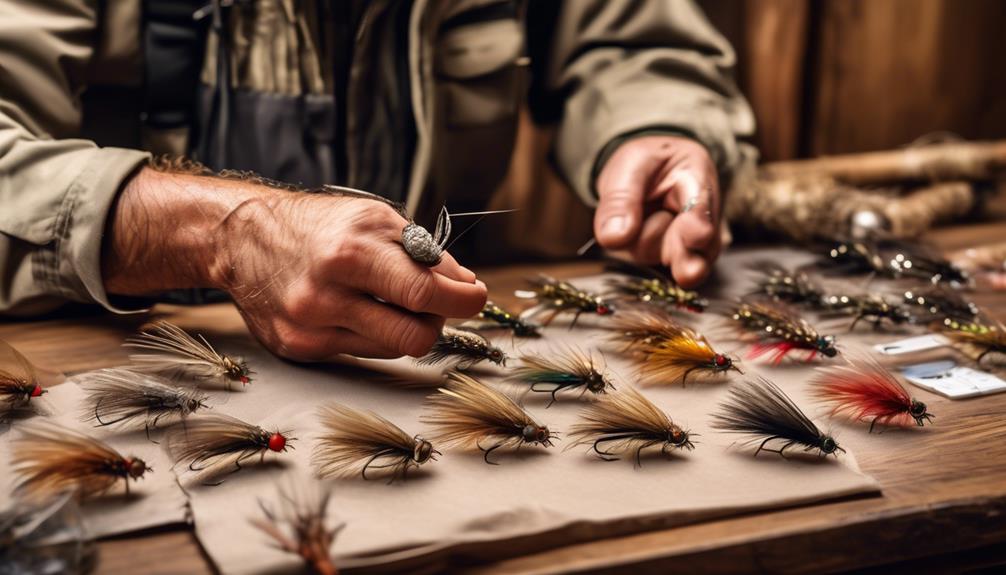
When selecting dry fly options, consider the prevailing insect activity and the specific water conditions to maximize your chances of enticing fish. Comparing different dry fly designs is crucial in determining which one best mimics the insects that are hatching at the time. For example, if you notice caddisflies hatching, opt for a dry fly pattern that closely resembles a caddisfly to increase your chances of success.
Additionally, evaluating dry fly presentation techniques is essential. This involves observing the behavior of the fish and adjusting your presentation to match their feeding patterns. If fish are rising aggressively, a more animated presentation might be necessary, whereas subtle sips at the water's surface might call for a delicate and precise presentation. Understanding the behavior of the fish and their feeding habits will help you choose the most effective dry fly pattern and presentation technique.
Moreover, it's important to take into account the water conditions. If the water is fast-moving and turbulent, a larger, more buoyant dry fly might be necessary to ensure it remains visible and afloat. On the other hand, calm and clear waters might require a more delicate and natural-looking fly.
Adapting to Changing Weather Conditions
In fly fishing, adapting your approach to changing weather conditions is essential for maximizing your success on the water. Seasonal adjustments and understanding weather patterns are crucial for honing your fly fishing skills. Here are some tips to help you adapt to changing weather conditions:
- Observe and Adjust: Keep a close eye on the forecast and be prepared to adjust your fishing strategy accordingly. If a cold front is moving in, fish tend to be less active, so you might need to switch to a slower presentation or smaller flies. On the other hand, a warm front can increase insect activity, prompting fish to feed more aggressively.
- Consider Water Temperature: Different species of fish have specific temperature preferences. As the seasons change, water temperature fluctuates, affecting fish behavior. During colder months, fish tend to move to deeper, slower-moving waters. In warmer months, they may seek cooler, oxygen-rich areas. Adjust your fishing spot and technique accordingly.
- Experiment with Fly Patterns: Weather changes can alter insect hatches, causing certain fly patterns to be more effective than others. Be prepared to switch up your fly selection based on the prevailing conditions. Pay attention to the insects present and try different patterns to see what the fish respond to.
Frequently Asked Questions
How Can I Effectively Present a Fly to a Fish in Different Types of Water Currents?
To effectively present a fly to a fish in different types of water currents, you'll need to master some effective techniques and presentation strategies. Consider the size of the fly, the fish you're targeting, and the water conditions.
Matching patterns to the local entomology and understanding the hatch importance can also improve your success.
What Are Some Common Mistakes Fly Fishers Make When Selecting Lures for Specific Water Conditions?
When selecting lures for specific water conditions, common mistakes include using the wrong size or color, neglecting to match the hatch, and ignoring the fish's feeding behavior. Ensure you understand the water conditions and adjust your lure selection accordingly.
Presentation techniques are crucial, so pay attention to the fish's behavior and adapt your approach to increase your chances of success.
Avoid these mistakes and improve your fly fishing game by honing your lure selection skills.
Are There Any Tips for Choosing the Best Fly Size for Different Types of Fish and Water Conditions?
When selecting the best fly size for different types of fish and water conditions, consider the fish behavior and the water conditions.
Matching the fly size to the type of fish you're targeting and the specific water conditions can greatly improve your chances of success.
Paying attention to these factors will help you make more informed decisions when it comes to fly selection, ultimately leading to a more rewarding fly fishing experience.
What Are Some Lesser-Known Insect Hatches That Can Still Be Important for Fly Fishing?
When fly fishing, don't overlook the importance of unusual hatches. Niche insect hatches can be crucial for fly selection. Keep an eye out for lesser-known hatches like midges, crane flies, and termites.
Although they may not be as popular as mayflies or caddisflies, these hatches can still play a significant role in attracting fish. Understanding and being prepared for these lesser-known hatches can greatly enhance your fly fishing experience.
How Can I Determine the Best Streamer Pattern to Use in Different Types of Water and Weather Conditions?
To determine the best streamer pattern for different water and weather conditions, start by matching streamer patterns to the prevalent food sources in the area.
Understanding weather patterns is crucial too. In murky water, opt for brighter and larger streamers to grab attention. In clear water, go for more natural and smaller patterns.
Also, consider how weather affects fish behavior – during cloudy days, try darker patterns, and during bright days, use lighter ones.
Conclusion
Mastering fly fishing lure selection takes time and practice, but with the right tips and tricks, you can improve your success on the water.
By understanding fish behavior, matching lures to water conditions, and identifying key insect hatches, you can increase your chances of a successful catch.
Keep experimenting with different fly sizes, patterns, and types to find what works best for you, and don't forget to adapt to changing weather conditions for the best results.
Happy fishing!
